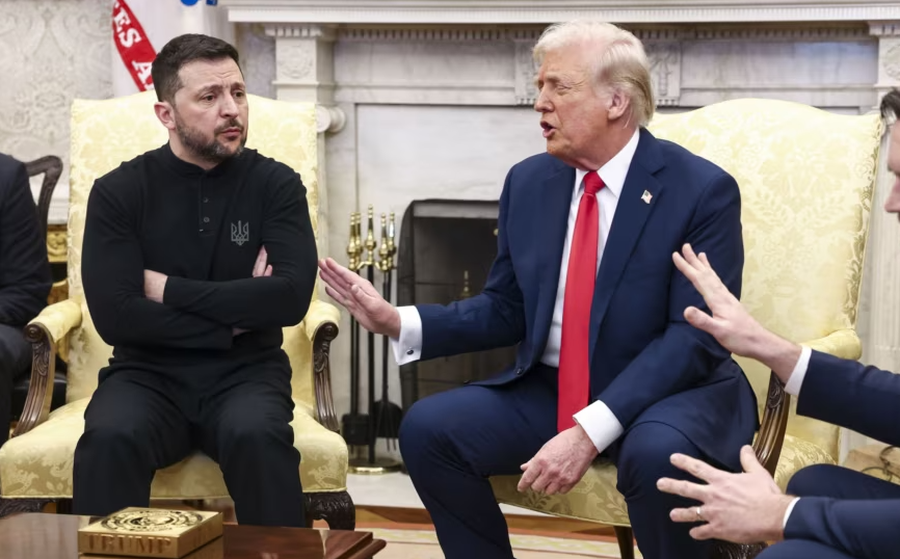
In Ukrainian and Russian, the term for 'rollercoaster' is “American hills.” That's an apt description for the fast-paced diplomacy that has unfolded over the past week regarding Russia's war against Ukraine, especially when it comes to the troubled relations between Washington and Kiev.
A White House meeting aimed at producing a mineral resources deal between the United States and Ukraine that President Donald Trump had touted as a key step toward ending the war went awry: No deal was signed and Ukrainian President Volodymyr Zelensky left early after a scuffle in the Oval Office. Trump said he “can come back when he’s ready for peace.”
That happened on February 28. Three days later, senior American officials told the media that Trump was suspending American military aid to Ukraine, creating more uncertainty about whether it can withstand a fourth year of a full-scale invasion launched by Moscow and increasing the urgency for European efforts to contribute more and fill the void – not just for Ukraine’s security, but for their own.
And the day after that, on March 4, to avoid new criticism of Kiev, in his speech before Congress, Trump said that Zelensky had informed him in a letter that he was ready for talks with Russia to end the war and was ready to sign the minerals agreement "at any time."
In the midst of this diplomatic storm, in this text you can learn what are the important things you should follow:
Will a mineral agreement be signed?
What Trump said in his March 4 speech suggested that Kiev and Washington could soon sign an agreement to jointly develop Ukraine's rare earth minerals and other resources. That would be a strong signal that things are back to normal after the disaster in the Oval Office.
But what Trump didn't say is also telling: He didn't escalate his criticism of Zelensky by saying the Ukrainian president doesn't want peace or by questioning his legitimacy and demanding that Ukraine hold elections soon. For now, it suggests that the US will treat Zelensky as an important figure in any eventual ceasefire or peace deal with Russia.
Will the suspension of military aid last long?
However, one thing Trump did not say was whether he would end the suspension of arms and other military aid to Ukraine. U.S. officials have said the suspension would end when Kiev shows a sincere commitment to peace, and Trump’s national security adviser, Mike Waltz, made clear on March 5 that this condition still remains in place. Trump “will seriously consider lifting this suspension” when peace talks are arranged and confidence-building measures are on the table, he said.
This puts pressure on Ukraine to take steps toward negotiating an end to the war, despite the lack of security guarantees from the US beyond the minerals deal, which, according to US officials, will help protect Ukraine by giving the US a strong interest in the country's stability.
How deep can the improvement of US-Russia relations go?
Trump made a splash when he reversed US policy by calling Russian President Vladimir Putin on February 12 and sending senior officials to Saudi Arabia to talk to their Russian counterparts about ending the war in Ukraine, reviving reports that had been painted as Washington's long-running efforts to isolate the Kremlin and punish it for the unprovoked war in Ukraine.
This raised concerns that Kiev and Europe could be sidelined and presented with a peace deal that would leave Ukraine vulnerable to further Russian aggression and undermine security across the continent. How US-Russia interactions unfold in the coming weeks could be crucial to the future of Ukraine, Europe, and the West.
Will Europe do more?
Trump's approach to Russia, shaky US-Ukraine relations, uncertainty over US aid to Kiev and a new chill in transatlantic relations have fuelled calls for Europe to do more when it comes to Ukraine's security and safety, including discussion of increasing arms supplies to Kiev and of an armed force that could be deployed in Ukraine in the event of a ceasefire or peace deal.
Whether these discussions can be translated into action and how quickly such a thing can happen could have a powerful impact on the fate of Ukraine and the future of Europe.
What about Russia?
In recent weeks, the escalation of diplomacy over the war in Ukraine has focused on the United States, Ukraine and Europe. But while the overall goal is to end the largest war in Europe since 1945, the state that is responsible for the war and could end it immediately if it wanted to – Russia – seems to have been sidelined in some cases.
For example, talks that an armed force could be deployed after a ceasefire have continued despite Moscow’s clear opposition, at least, to a NATO force, and despite the Kremlin’s claim that it wants a comprehensive peace deal—one that could give Russia influence over Ukraine and a stronger role in European security—and that it has no interest in a limited ceasefire. Russia has also said that any peace deal must recognize its claim to four regions of Ukraine, including parts that Ukraine still controls—a stance that is unacceptable to Kiev.
Some analysts say Russia has a history of using maximalist demands as a negotiating tactic, so that it can then retreat to positions that still serve its own purposes. Others say that, at least for now, Putin believes he can achieve grand goals, such as subduing Ukraine, and will use any ceasefire to build up his forces for a possible new offensive.
The US administration has said that Ukraine and Russia must make concessions for the sake of peace, but has said little about what those concessions might be in Russia's case. As Trump's peace efforts continue, it's also worth following what US and Russian officials say about the shape of a deal that would end the fighting./ REL (A2 Televizion)











